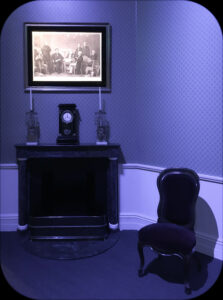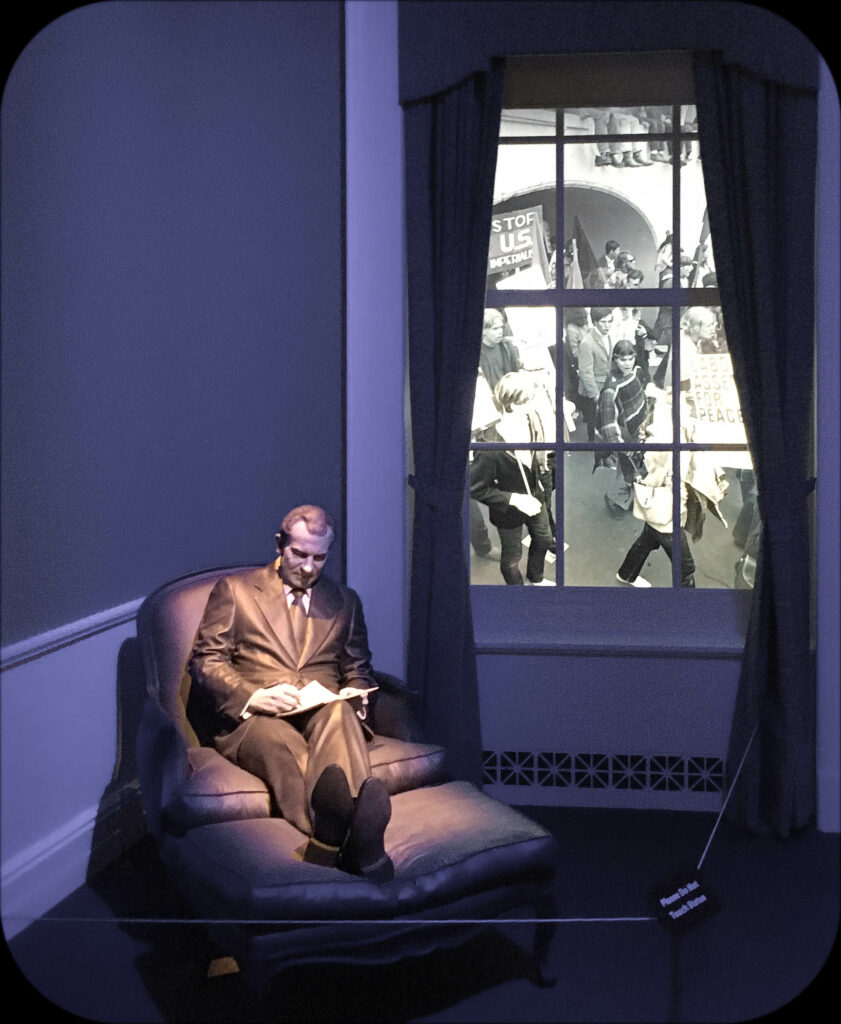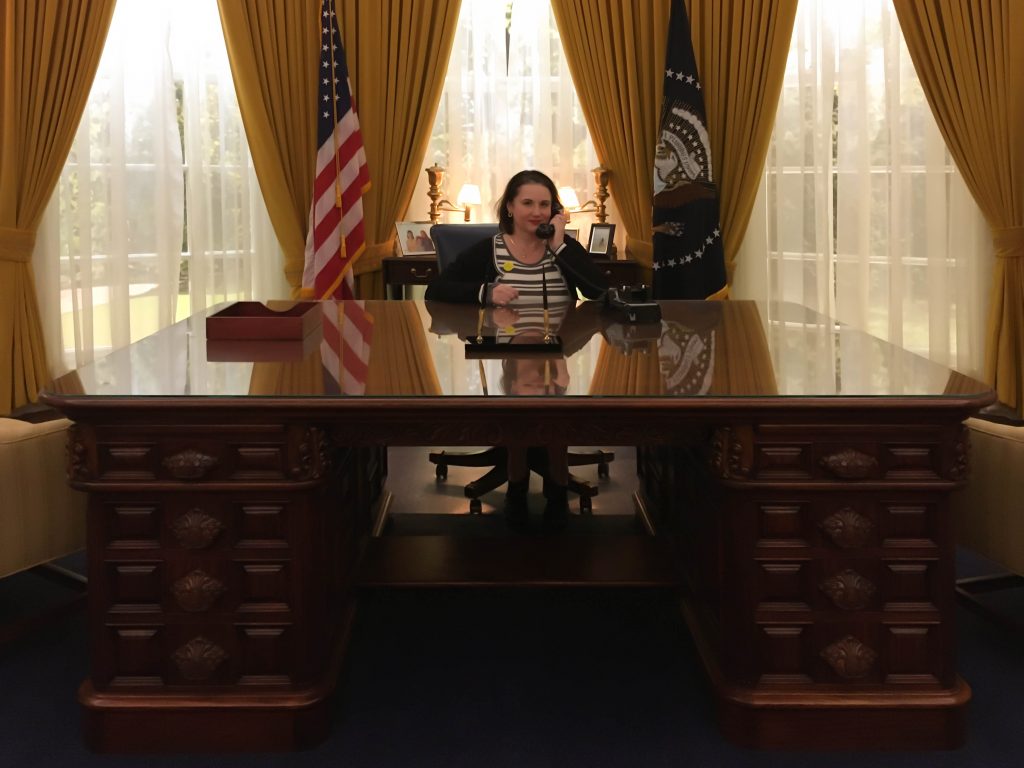The Richard Nixon Presidential Library and Museum in Yorba Linda, California, maintains:
- a large collection of materials related to America’s 37th President, his life, his family, his career, and his legacy
- the home where he was born in 1913
- the gravesite where he and his wife Patricia are buried

This post contains affiliate links. For more information, click here.
The Richard Nixon Presidential Library and Museum in Yorba Linda, California, offers a fascinating glimpse into the life and legacy of one of America’s most tragic public figures.
The Nixon Library sits on nine acres in Orange County, where I lived for a year and a half during my misspent youth as a wage worker. It houses a large collection of memorabilia, artifacts, clothing, and photographs relating to Richard Nixon, his family, and his presidency. It also maintains archives available to researchers.
The site includes the small home where Nixon was born and lived his early years, restored to appear as it did at the time of his 1913 birth. It also encompasses the burial place of the former President and his First Lady Patricia Nixon.
Of the 13 presidential libraries managed by the National Archives and Records Administration, it offers some of the most fun photo ops — like sitting behind (a replica of) the Resolute desk and riding in (a mock-up of) the Grand Marshall’s car in the Rose Parade.
Apollo 11
But the main reason my family and I visited on a warm October afternoon was to see the special exhibit Apollo 11: One Giant Leap for Mankind.
Neil Armstrong and Buzz Aldrin became the first men to walk on the moon six months to the day after Nixon became President. Moments after, he called from the Oval Office to congratulate the astronauts. Three days later, he personally greeted them at splashdown aboard the U.S.S. Hornet.
Visitors can view the telephone that Nixon used to make the call. They can also see artifacts like Aldrin’s penlight and the Presidential Medal of Freedom that Nixon awarded to Michael Collins, the astronaut who flew the command module around the moon while his crew-mates were walking its surface. And visitors can watch the coverage in a 1960s-styled “living room”, just as families did around the globe on that summer night in 1969.
The moon landing was the most significant technological achievement since the invention of the printing press. It established the United States’ scientific prowess. It helped sway belief around the world that the path to the brightest future lay along American-style capitalism rather than Soviet-style communism. It fostered American pride, American unity, American hope.
a decade of trauma
And those were things that America needed. The 1960s had been fraught with traumatic events: The disastrous Bay of Pigs invasion and the Cuban Missile Crisis. The building of the Berlin Wall. Multiple assassinations. Violent riots. Viet Nam. And the Soviets had beaten us into space with multiple “firsts”, including sending the first man into orbit, cosmonaut Yuri Gagarin, who would sadly die in a hushed-up training accident a year before Apollo 11’s historic flight.
The Library captures the epoch into which Nixon stepped as President in 1969. A section of the Berlin Wall recalls the human horror of communism. Visitors can listen in on Nixon’s phone call with POW Col. James Robinson Risner. And there are lighter artifacts as well, such as the iconic photograph of Nixon and Elvis Presley.
First Lady Patricia Nixon
There is a large exhibit on former First Lady Patricia Nixon and her contributions. She accompanied the President to Viet Nam and became the first First Lady to visit an active combat zone. She was also the first First Lady to visit Africa. She did so with diplomatic status, which allowed her to confer with national leaders and to represent her husband at the presidential inauguration in Liberia.
And she was the first First Lady to throw out the ball at a major-league baseball game, Game 2 of the 1971 World Series at Memorial Stadium, where the Baltimore Orioles crushed the Pittsburgh Pirates 11-3, before going on to lose the Series in Game 7.
Mrs. Nixon also continued the work begun by Jacqueline Kennedy in restoring the White House and recapturing the grandeur of its history. She redecorated seven major rooms and recovered hundreds of paintings and furnishings.
She began the nightly tradition of illuminating the White House. She opened up the White House to the taxpayers in new ways, beginning the garden and grounds tours and candlelight evening tours for people who worked during the day. Often she would personally greet tourists and even pose for pictures.
Also like Jackie Kennedy, she invited entertainers to perform, beginning a new series of “Evenings at the White House”, kicked off by Bob Hope. Johnny Cash appeared at another occasion, and 1776 became the first Broadway musical to be performed at the White House.
Washington insiders and wanna-bes covet invitations to events like these. But they are also important for the Presidents.
It’s difficult for a sitting President to enjoy a peaceful evening at a concert or the theatre. By bringing artistic performances into the White House, First Ladies like Mrs. Nixon, and Mrs. Kennedy before her, ensured that their husbands were exposed to the broadening and ennobling benefits of the arts, something we all need, but especially those who are in powerful positions that demand the daily spending down, rather than building up, of intellectual and sensual capital.
Nixon’s Background and Career
Sadly, the story of Nixon’s career is a morality tragedy of Shakespearean proportions, highlighting why character is the single most important determinant of presidential greatness or failure.
His early life was hard. But he had natural gifts and responsible traits. He was smart and did well at school, earning a scholarship to Harvard University. But his brother was ill, and so the future President had to remain in California to help his family. He graduated summa cum laude from local Whittier College. He accepted a scholarship to Duke Law School and graduated third in his class. He served his country, eventually becoming a Commander in the U.S. Navy.
Nixon first rose to national attention as a Congressman, when his tenacity led to the conviction of communist spy Alger Hiss. He was comfortably elected to the Senate and continued his vocal opposition to communism.
Republican presidential nominee Dwight D. Eisenhower chose him as his vice-presidential running mate. The two were elected in 1952 and comfortably re-elected in 1956.
He ran for President in 1960 and lost to John F. Kennedy. Despite credible allegations of voter fraud on the part of the Democrats, Nixon chose not to contest the election, saying it would be bad for the country. But he couldn’t let the resentment go.
In 1968, Nixon was elected President, defeating sitting Vice President Hubert Humphrey. His tenacity and ambition led to widespread foreign and domestic policy actions.
Watergate
But his resentment ultimately undermined his presidency. The Library has a large and even-handed exhibit on the Watergate scandal that ultimately forced Nixon to resign in the face of impeachment.
In 1971, the New York Times and the Washington Post published excerpts from the “Pentagon Papers”, a top-secret Department of Defense analysis of U.S. political and military involvement in Viet Nam leaked by analyst Daniel Ellsberg.
Within a week, the White House established a Special Investigations Unit, colloquially dubbed the “Plumbers” because their job was to stop leaks. Their first major operation was to break in to Ellsberg’s psychiatrist’s office in search of information that would discredit the leaker. The most significant result of this bizarre tactic was the dismissal of all criminal charges against Ellsberg in 1973.
Nixon was up for re-election in 1972, and the Plumbers turned their attention toward the campaign. On May 28, they broke in to the Democratic National Committee’s headquarters at the Watergate complex in Washington. They bugged phones and photographed documents. On June 17, they were caught and arrested while conducting a second break-in at the Watergate.
It is not clear whether Nixon had prior knowledge of the Watergate break-ins. It is clear that he tried to cover them up for more than two years. He reportedly dismissed the investigation as a witch hunt. He told White House Chief-of-Staff H.R. Haldeman to have the Director of the CIA pressure the acting director of the FBI to stop the Bureau’s investigation. He ordered the firing of special prosecutor Archibald Cox.
Citing executive privilege, he initially refused to turn over tapes of his conversations in the Oval Office, releasing edited transcripts instead. Ultimately the Supreme Court required him to provide the tapes themselves.
On August 5, 1974, he released a recording of a June 23, 1972, conversation with Haldeman. In it, the two discussed their plan to block investigations. This tape has become known as the “Smoking Gun”.
It’s also clear that he fostered the kind of resentful and relativistic atmosphere in which crimes like these are likely to occur. Asked about his 1972 campaign’s “dirty tricks”, he rationalized:
I’ve been the victim of … dirty tricks, including bugging …. There’s a very famous character, a real professional, delightful fellow as a matter of fact, named Dick Tuck. And he used to sabotage our campaign schedules and send people the wrong way and … disrupt our meetings and so forth. … But the media being … not particularly in my corner … just called that ‘fun and games’. And then … [Donald] Segretti, … our so-called dirty tricks man, whom I frankly have never had the opportunity of even meeting, when he tried to practice some of these things on our … Democratic opponents, … they became high crimes and misdemeanors. … It’s just a double standard. … This sort of thing happens in campaigns. I don’t particularly like it. … But it’s gonna happen because people are human.
Such resentment and relativism, anathema to any true conservative philosophy, were Nixon’s downfall.
By the time the Smoking Gun tape came out on August 5, the House Judiciary Committee had already passed three Articles of Impeachment against him. Public outrage to the recording was enormous. What little political support Nixon had left evaporated.
On August 7, a small Congressional delegation visited Nixon in the Oval Office and told him that he would almost certainly be impeached by the House, convicted by the Senate, and removed from office.
On the morning of August 8, he informed Vice President Gerald Ford of his decision to resign. That same evening, he told the nation, stating his hope that by resigning he “will have hastened the start of that process of healing which is so desperately needed in America”, echoing his rationale for not contesting the loss to Jack Kennedy just 14 years earlier.
On the morning of August 9, Nixon became the first U.S. President to resign, and Gerald Ford was sworn in as the 38th man to hold the job. On September 8, Ford pardoned Nixon for all crimes he “committed or may have committed or taken part in”.
Nixon returned to California and arguably became a successful ex-President, writing books that range from self-serving memoirs to important foreign-policy warnings. He remained devoted to his wife Pat until her death on June 22, 1993. He followed her less than a year later on April 22, 1994, having never fully accepted responsibility for wrong-doing.
Life isn’t fair. Some people face hardship, manage to succeed, gain confidence from their successes, and achieve greatness. Others face hardship, manage to succeed, but never let go of their resentment, and suffer even more. That’s why the final saga of the Nixon presidency was a personal tragedy, for the disgraced President and his family, and for the men who enabled him, many of whom went to prison, and for their families.
While it may well have been, in the words of Gerald Ford, a “national nightmare”, it was not a national tragedy. It was in fact a testament to the greatness of America and the genius of her founders. Impeachment, conviction, and removal from office form a deliberative remedy to the problem of corrupt officials. This remedy is not a witch hunt, which historically has led to the hanging of innocent people. It is not a coup, which means the bloody overthrow of an established regime. It is a just and peaceful process.
Our founders wrote this remedy into our Constitution because they knew long before Lord Acton that “power tends to corrupt” and that America would one day need the means to remove a President who had “rendered himself obnoxious”, in the words of Benjamin Franklin. They were brilliant men, well-read in history, philosophy, and literature, and they knew what they were doing. If the Constitutional system they bequeathed us has a weakness, it is the one identified by Franklin: “Only a virtuous people are capable of freedom. As nations become corrupt and vicious, they have more need of masters.”
This is why preserving a Constitutional republic requires the removal of unvirtuous Presidents: It cannot survive them over time. The founders gave us a peaceful and deliberative process to do so. It’s one more mark of their genius, and one more reason why America has always been great.
What to Know before You Go to the Richard Nixon
Presidential Library and Museum
The Nixon Library is located at 18001 Yorba Linda Boulevard in Yorba Linda, California.
There is ample complementary parking.
Wear comfortable walking shoes.
Allow three to six hours.
Resources to help plan your trip to
Yorba Linda
Book flights. The closest airport to the Nixon Library is John Wayne, 20 miles away; its code is SNA. The closest major airport is Los Angeles International, 41 miles away; its code is LAX.
Reserve accommodations. Booking.com lists several four- and five-star hotels within 10 miles of the Nixon Library. If you prefer a private house or apartment, VRBO has dozens near Yorba Linda.
Secure ground transportation. DiscoverCars is a good site for comparing rental options.
Make dinner reservations.
Use the right rewards credit cards. Some good options that pay you cash-back or travel points:
- Bilt pays 3 points/dollar on dining and 2 points/dollar on travel, doubled on the 1st of each month.
- Capital One Quicksilver pays 1.5 percent cash-back on all spending.
- Capital One Savor pays 4 percent cash-back on dining and entertainment.
- Capital One Venture X pays 2 miles/dollar on purchases.
- Discover pays 5 percent cash-back on categories that rotate quarterly and 1 percent cash-back on other spending.
Join Rakuten. The program pays you cash-back for booking through its portal. As of this writing, Rakuten is offering up to 9 percent cash back at Booking, Tripadvisor, and VRBO.
Protect your peace of mind with:
Read reviews. Not sure about something? Tripadvisor has lots of real-people reviews for things to do in Orange County.
After my misspent youth as a wage worker, I’m having so much more fun as a blogger, helping other discerning travellers plan fun and fascinating journeys. Read more …


